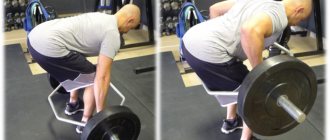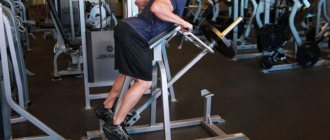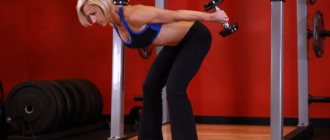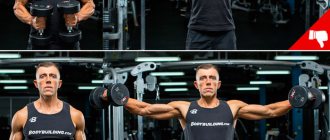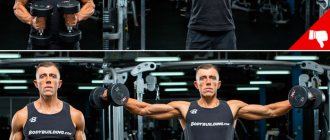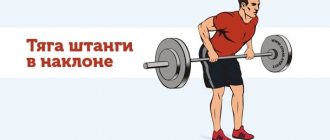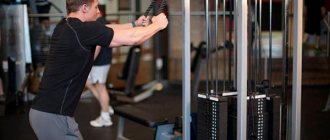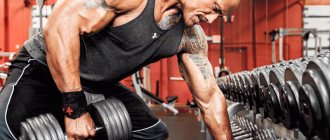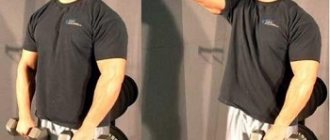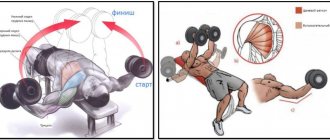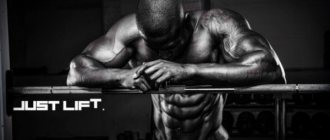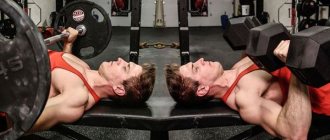If you think that your back muscles cannot be pumped up with dumbbells, then you are mistaken. And this can be done through the dumbbell row exercise. It can be performed either with each hand in turn, or with both hands tilted towards the waist.
The bent over dumbbell row is an effective basic classic exercise that can help you effectively develop your back muscles, as well as give them strength and definition.
The exercise is aimed primarily at developing the thickness of the back muscles. Regular exercise will lead to muscle growth in the target muscle group and give the figure a masculine, athletic V-shaped silhouette, which is so highly valued in bodybuilding and fitness.
Working muscles
Bent-over dumbbell rows are primarily aimed at pumping the latissimus dorsi muscles. Correct execution involves the greatest load on them.
Additionally, the following muscles are involved:
- Teres major muscles;
- Trapezoid;
- Back extensors;
- Rear deltoids;
- Rhomboid muscles;
- Biceps and forearms.
The exercise helps develop the thickness of the upper back, as well as its middle. Performing rows also requires significant participation of the rotator cuff, therefore, when performed correctly, the interscapular areas of the back muscles and the muscles that are located just below are actively activated. However, many people doing bent over rows do the exercise without feeling the contraction of the back muscles and “spread” the load across all the muscles.
As already mentioned, you can pump your back either with one dumbbell or with two dumbbells at the same time. In this case, the torso can be located either in a standing position, or with the knee of one leg resting on the bench, or even in a prone position on the bench. All of these exercise options are discussed below.
What muscles are involved?
The bench row is considered an isolated exercise for working the rear deltoids. But in fact, it also involves other muscle groups:
- upper and lower back;
- lats;
- trapezoidal.
In the bench row, the main emphasis of the load can vary depending on the grip. So, if you hold dumbbells with a straight grip, then the main work will be done by the rear deltas. But if you hold the exercises with a neutral grip, then the lats will take most of the load.
Both groups in this case can be called main. Although the load can vary depending on the grip, when performing bench rows it is impossible to completely exclude the second group from the movement. This is because the upper and lower back, as well as the latissimus, are stabilizer muscles.
Benefits of Dumbbell Rows
Key features of the bent over dumbbell row include:
No. 1. Heavy load usage and execution safety.
The exercise is performed with free weight and is basic multi-joint in nature. The exercise allows you to work with a heavy load, while the load on the spine is minimal, so the exercise is a good option for people with lower back problems.
No. 2. Accessibility and use of free weights.
Bent-over dumbbell rows effectively strengthen the back muscles and do not require special training equipment or complex equipment. Therefore, the dumbbell row can be used as an exercise in the initial stages of training, as well as for home training.
No. 3. Variability of execution.
Because deadlifts use free weights, dumbbell rows can be performed from different positions and angles, allowing you to better feel your back muscles and get the most out of all areas of your back.
Other positive effects
In addition, bent over dumbbell rows can strengthen your lumbar region, improve your posture, get rid of hunched shoulders and keep your back muscles toned.
Row of two dumbbells to the belt
The exercise resembles a standing bent-over barbell row. If the athlete already knows how to perform this deadlift, his task becomes easier. It is enough to select the weight of the dumbbells. The exercise allows you to work your back and does not overload your leg muscles. It is technically simpler than the bench-supported row option, as it requires almost no stretching.
When taking the starting position, it is important to grip so that the dumbbells do not hang on the athlete’s fingers. The grip should be the same on both sides. The athlete performs a slight forward bend, the universal starting point is a back tilt of 45 degrees. Then you need to bend your knees slightly so that you can stand comfortably and the load does not go into the hamstrings.
Next, the exercise is performed by bringing the shoulder blades together, that is, the start occurs by bringing the shoulder blade to the spine, then bringing the dumbbells to the belt. The elbows move in a plane parallel to the spine. It is not recommended to move the forearms perpendicular to the spinal column. The exercise is performed smoothly; the movement should not be jerky or jerky. The biceps are flexed just enough to bring the dumbbell to waist level.
This exercise can be performed in the “balance” version, that is, pulling one dumbbell at an angle towards the waist. This is a rarer option, it is used in strength sports to balance the work of the halves of the athlete’s back. This option is quite rare in bodybuilding, but it makes sense if an athlete has difficulty performing bent-over rows with a barbell and tends to extend too sharply as the barbell moves towards the waist.
Bent-over dumbbell row: technique
Dumbbell rows while lying on a bench
In this version, the backrest is installed so that the athlete can bring the dumbbells to the belt by tensing the latissimus dorsi muscles. The task becomes more difficult, since the legs only rest on the floor, and it will not be possible to pull the weight by slightly extending the back. Many people consider this row to be similar to the T-bar row, but this is not entirely true. The weight is distributed absolutely evenly, and therefore it turns out to develop the muscles harmoniously.
To perform this option, it is enough to tilt 30 degrees, lie on the bench with your stomach, grabbing dumbbells, and bring them to your waist, while simultaneously pulling your shoulder blades towards your spine and contracting your back muscles. The biceps should not pull the weight alone; the start occurs by bringing the shoulder blades together and contracting the lats. In this exercise, the rhomboid muscle also works, but the trapezius muscle is turned off due to emphasis and stabilization.
Errors
Insufficient body tilt. If the inclination is too high, you can transfer part of the load to the trapezius muscles. This will lead to the back not being worked enough. The same thing happens when an athlete actively “pulls” his body, performing small amplitude lifts;
Too much weight. If an athlete cannot retract their shoulder blades with any variation of the bent-over row, the weight is too heavy. In this case, the weight is “accelerated” by the biceps, which can lead to ligament injury;
Performing the exercise in jerks. Snatches throughout the entire amplitude are not only a traumatic activity, but also a technique in which the load goes into the body. When jerking, impact injuries are possible, as well as increased stress on the spine;
Raising your elbows to the sides. Some athletes perform swings instead of flyes, this leads to a transfer of load to the rear deltoid
Execution technique
The exercise is best performed using a bench (horizontal or inclined) or another fulcrum (a row of dumbbells).
One-arm dumbbell row
Starting position: lean the knee of your left leg on the bench, also lean on the bench with your left hand. The angle between the legs and body at the hip joint should be straight. Keep your back straight, arched in the lumbar region. This arched position of the lower back allows you to keep the spine in the position necessary for correct execution of the exercise. At the same time, the right leg is slightly pulled back and placed on the floor to maintain balance.
Don't lift your neck too high or twist it. The chin is parallel to the floor and the gaze is directed forward. For convenience, it is better to place the dumbbell next to the bench.
- From the starting position, take the dumbbell so that its bar is parallel to your body.
- Contracting your lat muscles, pull the dumbbell towards your waist. At the same time, the elbow is retracted as much as possible.
- At the peak point of contraction, it is recommended to linger for 1-2 seconds and additionally feel the tension in the working back muscles. Keep your spine straight.
- Then lower the dumbbell back down to the starting position. If possible, move the dumbbell back a little, rather than just lifting it perpendicular to the floor. Otherwise, you will perform pull-downs towards the chest, and not towards the waist, which is incorrect from the point of view of execution technique.
Perform 8-12 repetitions for 3-4 sets with each arm.
When performing, it is necessary to keep the body motionless so that the spine does not twist. Do not raise your elbow too high, as this will inevitably cause spinal rotation.
If it is difficult for you to keep your lower back arched while performing bent over dumbbell rows with one hand on a horizontal bench, you can use an incline bench. For what:
- Set the incline of the bench to 30 degrees.
- Raise the seat of the bench up slightly and stand on it with your knee as well.
- Bend the arm corresponding to the side of the body that is on the bench slightly at the elbow and rest it on the upper part of the back of the bench. As a result, you will be able, while maintaining the load, to keep your back straight and arched in the lower back due to the bend of the bench.
If this implementation turns out to be more convenient for you than in a traditional warrant, then do dumbbell rows in this version.
Row of two dumbbells to the belt
This variation of the exercise is performed both in a standing position and in a lying position on an inclined bench. Each hand should hold the dumbbells using the grip that is most comfortable for you.
Standing two dumbbell row
Let's look at the technique of performing rows of two dumbbells to the belt without a bench:
- To begin, bend your knees slightly, keep your back straight, and bend over until your back is just above parallel with the floor. At the same time, the areas of the back muscles that will bear the load depend on the degree of inclination. If you stand with a slight inclination, your upper back will work more. If you bend closer to a parallel position, the latissimus muscles will be activated more strongly, however, a stronger load will be placed on the lumbar region. We recommend using a tilt of approximately 45 degrees. Look straight, chin parallel to the floor.
- Place both dumbbells on straight arms directly under your shoulders with your arms perpendicular to the floor.
- Begin to row the dumbbells straight up, do not spread them to the sides. Try to pull the weight with your elbows towards your waist. Watch your elbows; the correct technique depends on the amplitude and direction of movement. Pause for 1-2 seconds at the top and lower the dumbbells to the starting position. Try to stretch your back muscles by lowering your hands with dumbbells as low as possible, but at the same time, do not completely relax your back muscles.
Do 3-4 sets of 10 reps each.
Please note that the weight must be pulled using the strength of the back muscles, and not due to the biceps brachii muscle.
It is not recommended to use one dumbbell for two-handed rows. In this case, you will not be able to maintain the required range of motion, as a result of which the exercise will not be effective.
Bent over row of two dumbbells
Set the angle of the incline bench to 30 degrees relative to the floor. Lie on your stomach so that your neck is free and your head is higher than the edge of the backrest. Your arms should be straight, but not touching the floor.
Place the dumbbells at the base of the bench so that you can reach them with your hands. Push your feet so that your body is in a stable position. Don't make the backrest angle too large, otherwise you will slide down.
The movement is performed in the same way as in the standing variation. This option provides you with an isolated load on the back muscles, since the fixed position of the body excludes the back extensor muscles from working. In addition, the lower back does not receive traumatic stress.
Errors
Check out common mistakes when doing exercises:
- Do not lower your head down, as you will disrupt the natural deflection of the spine, which leads to an increased risk of injury during the dumbbell row.
- Do not pull the dumbbell towards your chest. If you find it difficult to pull towards your waist, try reducing the weight.
- Do not use jerks when performing. Otherwise, you will not be able to effectively work your muscles, moreover, it may lead to injury.
- Don't round your back. If you lack flexibility or find it difficult to maintain balance with an arched back, you can use the incline bench option.
- If you experience discomfort in your hand resting on the bench (shaking, weakness), this means that you should use an incline bench for now, or try a cable variation or another hand position.
- Do not spread your arms, but pull the dumbbells, which should be held freely by your forearms and simply hang down.
- Do not use excessive weight and pull the implement through its full range of motion. If it is difficult for you to raise your elbows to the required height, then you should reduce the working weight.
- Use the strength of your back muscles to pull dumbbells. Imagine that your arms are just hooks that lift the weight.
- Insufficient bending when standing bent over dumbbell rows.
Exhale with effort (dumbbell pull), and lower with inhalation.
Correct technique
It would seem that it could be simpler - we put the backrest on an incline of 30 degrees, sit on a bench, dumbbells in our hands, lower ourselves, press our shoulder blades and pelvis, bring the dumbbells up, lower them, squeeze them out. But here too there are “platforms for discussion”:
- Some coaches consider the dumbbell bench press to be a technical error if the back is in a natural arch. They consider this deflection to be analogous to a lifter’s “bridge” and say that this does not allow them to pump up their chest;
- Others argue that when the shoulder blades are brought together and lowered to the floor, and the pelvis is rigidly fixed, it does not matter where the athlete's lower back is located. There is no particular meaning in her “forcible” pressing to the bench. But the heads of the shoulders, looking forward, are a violation of the anatomical plane of the joint, and the cause of injuries
Does the chest work if the lower back is separated from the bench? Yes, because otherwise it is simply not possible to start from the bottom position of the bench press. In order to achieve emphasis, you should simply lower the dumbbells completely.
Is it possible to get injured if your back is arched during the bench press? Yes, too, but only when the athlete lies unstably on the bench, his legs are relaxed, and his top is “assembled”, but not correctly. This refers to the adduction of the trapezius muscle to the ears.
In fact, the correct technique is possible by:
- Shoulders away from the ears;
- Assembled blades;
- Firmly rest your feet on the floor, without them slipping;
- Work along the correct trajectory, without pushing the dumbbells towards the eyes
The back should be stable, not neutral. “Jumping” on the bench, attempts to push the weight up, and changing the position of the lower back are not allowed. If it is slightly bent and the athlete is comfortable in this position, it’s okay.
Technically, the bench press is performed like this:
- The athlete sits on a bench, brings his shoulder blades together and removes his shoulders from his ears;
- Then he lies down in his original position;
- The assistant helps to bring the dumbbells to the level of a line passing through the plane of the middle of the chest;
- Dumbbell bars are perpendicular to the spine, the grip is straight and closed;
- Wrist creases are excluded;
- As you inhale, lower the dumbbells to the lowest point of amplitude, if possible, closer to the point at which the bar of the bar could rest on your chest during a bench press;
- As you exhale, you need to consciously tighten your chest and push the dumbbells up;
- Another controversial point is the position of the elbows. Should I extend it completely or leave it slightly bent? If control over the implements is not lost with “soft elbows,” you don’t have to fully extend them. But those athletes who cannot hold dumbbells in a way that keeps their bars stable should use lighter weights and stick their elbows in.
Important:
- When performing bench presses to work the pecs, pay attention to the angle of the bench. If the back is tilted at an acute angle, the load shifts to the front deltoids. It is ideal to place the bench at 30-45 degrees and no more;
- There is no need to choose dumbbells that are too heavy. Heavy weight allows you to achieve significant hypertrophy, but if an athlete cannot keep the bars in one plane, “pulls” the dumbbells up on one side, and actively hyperextends his elbows, he provokes injury. A little muscle shaking and instability is allowed during the last reps.
- Overload of the cervical spine should be avoided. Athletes who rotate their heads during exercise, try to put weight on the neck, and actively overload the cervical spine can cause a pinched nerve. If you have an irresistible desire to stand in a kind of bridge with support on your neck, do not flatter yourself - the dumbbells are too heavy, you should choose an adequate weight. If such a mistake is repeated regardless of the weight of the dumbbells, you should place a pancake or other support under the bench, since it is simply too low and the athlete “warps” because of this;
- When lifting dumbbells on your own without the help of a spotter, they are not lifted onto the biceps or brought up from the floor. They are placed on the hips and raised by pushing the legs;
- Before pressing dumbbells, you need to straighten your back on the bench and stabilize your body position, so that when lowering the dumbbells, your pecs are stretched
Read more: Boldenone combination dosage features Prima effect
You can control yourself according to the following parameters:
- The athlete touches the bench with the back of his head, shoulder blades and pelvis;
- The projectiles are lowered into a line passing through the center of the chest, and can rise to the line of the collarbones;
- The press trajectory is not linear, but elliptical;
- During the movement, pushing the weight, unintentional pauses throughout the entire amplitude, and active assistance of the body are excluded;
- Exhalation is carried out with effort, while inhaling it is necessary to lower the dumbbells, as if opening the chest;
- Shoulders and elbows need to be strictly controlled, to prevent them from “breaking” and unnatural trajectory.
Errors
Technical errors in the dumbbell press are the movement of the projectiles both to the eyes and to the stomach, uneven press, displacement of the dumbbells and not a tight grip.
A separate category of errors occurs due to the fact that the athlete’s legs slip, or he places them loosely on the floor, refusing rigid fixation.
It is necessary to monitor the trajectory of the dumbbells, choose equipment that is adequate to your training level, and do not forget that the mechanics of movement consist of lowering and lifting, and an error in lowering (too high or low) can cause a violation of the trajectory of the press.
Work at a moderate pace and mentally control your movements.
- Decide on the back angle.
- Sit on a bench, press your lower back and squeezed shoulder blades tightly against the back. Place your feet firmly on the floor with your feet wide apart.
- Grab the weights with an overhand grip and lift them closer to your deltoids with bent arms.
- Inhale with all the power of your lungs, hold your breath, and with a coordinated movement, lift them along the trajectory of a wide arc.
- Once you cross the midline, exhale.
- Straighten your elbow joints, bring your hands together above your collarbone. At the climax, pause for a second.
- Inhale and go into the negative phase.
- Lower the projectiles to your shoulders and squeeze without delay.
Using this principle, perform lifts with one hand, trying to lift them as high as possible. It is not forbidden to tear the shoulder off the surface.
Most novice athletes who come to the gym for the first time make a huge number of mistakes. If you are a complete beginner in the world of weightlifting, be sure to use the services of an experienced mentor, because the technique of performing a dumbbell bench press is not as simple as it seems from the outside.
Beginners are recommended to go to the gym with a friend for the first time. The dumbbell overhead press requires a special technique from the athlete. But if you do not have the opportunity to exercise with a partner, then remember a special algorithm for performing movements.
Before starting the exercise, you must select dumbbells of the appropriate weight. Work with a light load at first. At first, the athlete needs to work on improving technique. After you can perform all the elements correctly, take heavier sports equipment.
Adviсe
If you use different angles between the arm and torso during the pull, you can mix the load on different parts of the muscles. If you spread your elbows wide, the rear deltoids are actively involved in the exercise. The latissimus dorsi muscles work best when the elbows are closer to the body, as when gripping a regular barbell.
Thus, you can pump up certain areas of your back, from time to time alternating, for example, the option with elbows near the body, and the option with widely spaced elbows. And do not forget to pull the projectile towards your belt, otherwise the effectiveness of the exercise will decrease.
- during execution, the forearms do not actively work to bring the projectile upward;
- do not release the load while excessively straightening your arm at the lowest point throughout the entire range of motion;
- pull the dumbbell to its full amplitude without shortening it, for which you should select a moderate weight;
- keep the shoulder of your working arm in a fixed position, do not lower it at the lowest point;
- try to raise your elbow with the apparatus as high as possible, without pulling the dumbbell to the side;
- do not round your back, and also keep your head straight, do not look down;
- It’s better if there was a mirror in front of you when performing the exercise, this will allow you to control the process of execution;
- if you work with heavy weights, it is recommended to use special traction straps to hold and relieve the load from your hands;
Basic rules for performing the exercise
In the dumbbell row, you need to take a weight that you can lift 12-15 times. We take dumbbells in our hands with a standard grip and take the starting position, that is, we bend over and turn our palms towards ourselves
It is important here to move your pelvis back as far as possible, because if you just tilt, the position for the back muscles will be unfavorable; they will experience too much stress. At this moment you will think about them, and we need to work on the upper back
Therefore, we move the pelvis back so that your legs are at the level of the upper abdomen. You can also do bent-over dumbbell rows to the chest, in which case the trapezius muscles develop.
A very important point during execution. We lower ourselves until your hand is below the kneecap. We open the shoulder blades as much as possible and unfold the brush. This is the first phase of this exercise.
In the second phase, we exhale, begin to raise the shoulder blades as high as possible, and only at the top point we work with our elbows in order to contract the working muscle even better. As you move, you need to slightly supinate the hand. Don't forget that the shoulder blades work first, and then the elbows. During execution, you should not lift your head, as this prevents our trapezius muscles from contracting better. After completing the planned number of repetitions, return the dumbbells to the floor and feel how the lats have been worked.
Please note that the muscles of the lower back work in a static mode, and there should be no dynamics there. The exercise should target your upper back.
In the next article we will reveal all the secrets of the features of training on an elliptical trainer.
Dumbbell row lying on stomach
To work the deltoid muscles, you need to lie on a bench and lift the dumbbells alternately, as this allows you to raise them higher. As you inhale, you need to raise the dumbbell to chest level, and while exhaling, lower it to its original position.
How to hold a dumbbell when deadlifting
When pulling two dumbbells to the belt, just like when pulling a barbell in an inclined position, you can hold them with different grips.
There will be no significant difference. Also note that by increasing the angle between the body and the shoulder (spreading the arms further), the position of the dumbbells will also change, they will turn more to the sides.
Once your back muscles are stronger, you will be able to use significant weights when performing dumbbell rows. However, be careful when choosing the working weight for the exercise, since excessive weight, especially when standing deadlifts, can lead to back damage. In addition, the execution technique will be disrupted, and you will have to pull using jerking movements.
Bent over dumbbell rows are an excellent exercise for girls to develop their back muscles. And also an excellent exercise for working out the relief as an isolated load after more difficult basic exercises.
Dumbbell bench press on a horizontal bench
By and large, this exercise is an alternative to the classic bench press. The technique for performing this exercise is quite simple:
- Starting position: you lie on a horizontal bench. You hold dumbbells - they are at the lowest point.
- Press the dumbbells with a powerful upward motion.
- You don't fully extend your arms. At the top point you need to linger for 2-3 seconds. This is necessary in order to work out the chest muscles as much as possible.
- After which, you smoothly lower the dumbbells to the starting position.
- At the lowest point, you must also hold the dumbbells for 3-3 seconds. This way we will achieve a good muscle stretch.
- Perform this movement 12-15 times.
The dumbbell press differs from the barbell press only in that at the bottom point you can stretch the chest muscles much better. And at the top point you can turn your palms or press like this initially. This will force more muscle fibers to work.
The main thing is safety. There are known cases when an athlete picked up dumbbells with an inaccurate jerk and suffered a sprain. Therefore, it is better for your friend to give you the dumbbells.
Read more: Andreas Münzer, a ripped man without skin - Bodybuilding and fitness
Possible problems and contraindications
- If you have problems with the rear deltoid muscles, then it is not recommended for you to perform dumbbell rows. These areas of the deltoids will definitely be included in the work in any version of the exercises presented.
- If you don't have good stretching and flexibility in your joints, you will have a hard time getting into the correct starting position with a backbend to perform the deadlift. Even if you use an incline bench, lying with your stomach face down, a deflection is required in the lumbar region. Therefore, it is recommended to warm up, stretch before performing this exercise and work on stretching.
Video - Bent-over dumbbell row:
Common Mistakes
Inaccuracies in technique lead to a decrease in the effectiveness of training. In addition, some inconsistencies during execution are dangerous for the joints or spine. It is necessary to reduce the weight of the dumbbells and change the modification of the exercise if the following signs are noted when performing deadlifts:
- there is not enough strength for a full lift, the hand with the projectile moves only half the amplitude;
- the beginning of the pull is performed with a jerk, the biceps muscles working at the moment of start indicate a shift of the load from the desired muscle zones;
- “round”, the back is hunched, which means there is not enough stretching - it is worth considering the option of an incline bench;
- the head is tilted forward, which violates the anatomical position of the spine and creates a risk of pinching;
- The dumbbells are pulled to the chest, not to the stomach.
If the technique is followed, then after training the athlete feels fatigue in the muscles between and under the shoulder blades. During training, the athlete concentrates on the correct distribution of muscle work; the biceps and arm flexors should be minimally loaded. Only in this way will dumbbell rows give the desired result and become a key exercise for strengthening the back.
Beginners and experienced athletes regularly perform bent-over dumbbell rows. The classic base is modified for different levels of training, performed with small and large weights. This is a great way to get a balanced, developed back, work the latissimus muscles and improve your posture.
